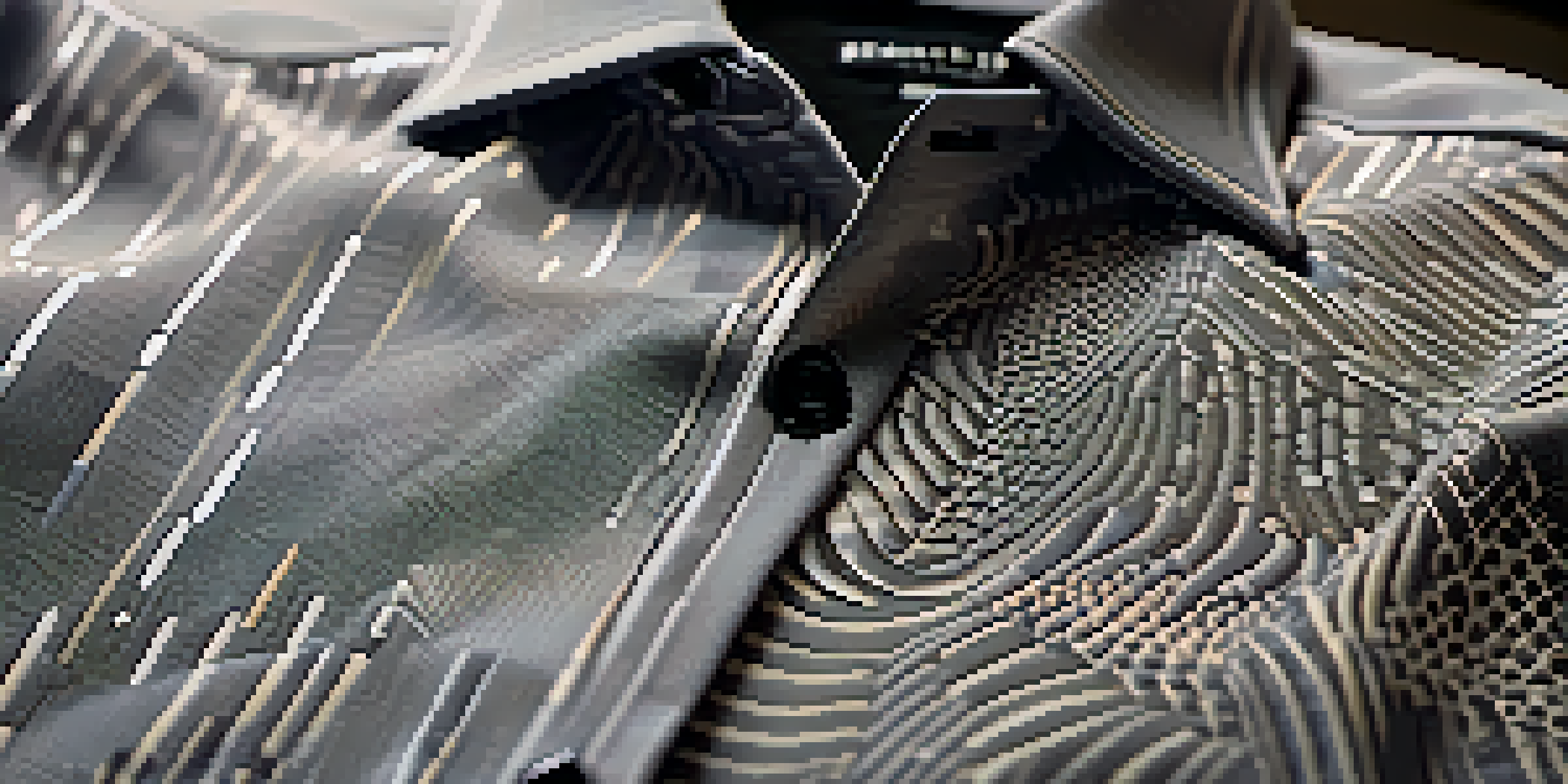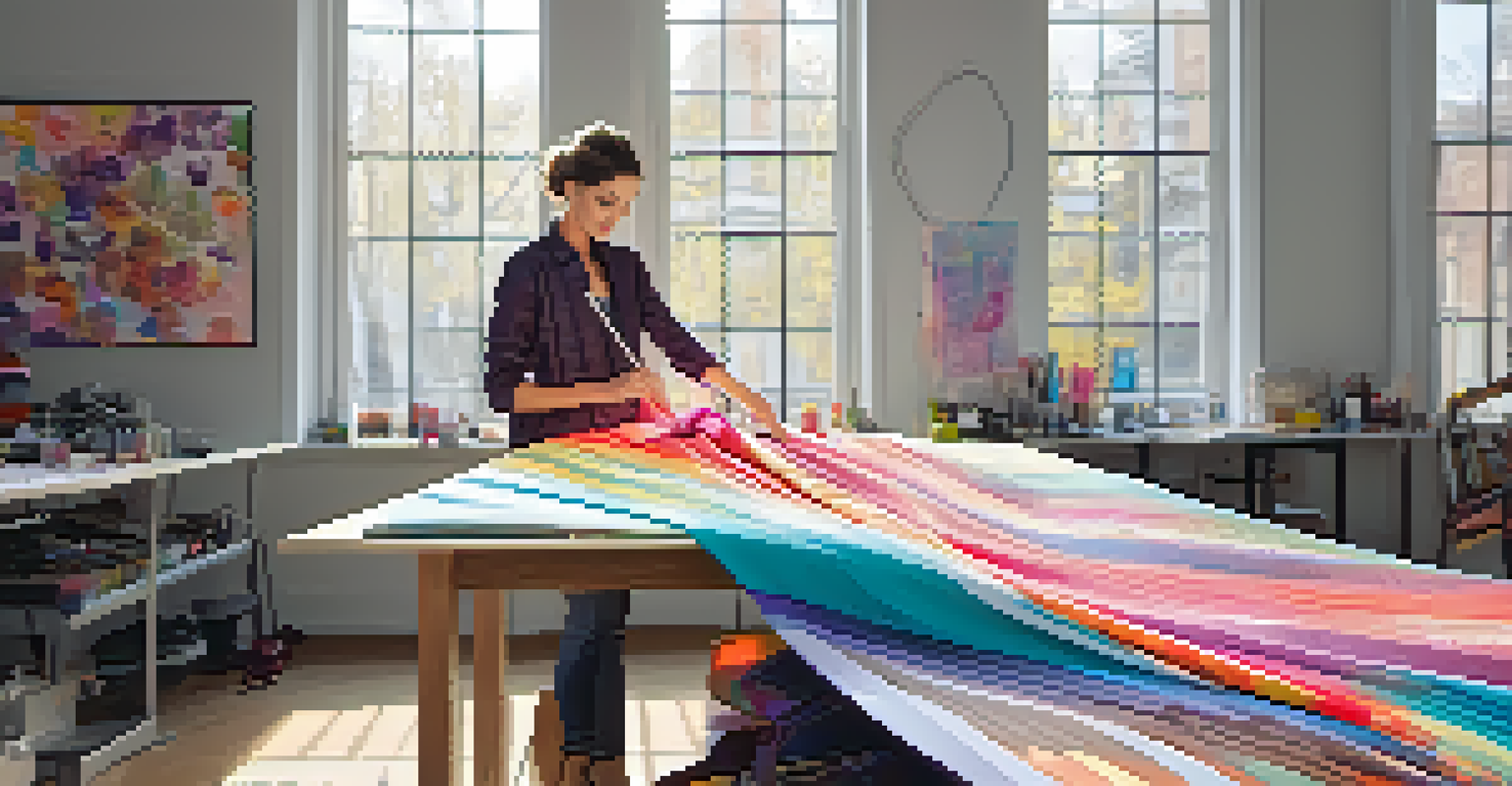Smart Fabrics: Wearable Tech for Health Monitoring in Fashion

What Are Smart Fabrics and Why Do They Matter?
Smart fabrics, also known as e-textiles, are materials embedded with technology that can sense and respond to environmental changes. They bring innovation to the fashion industry by integrating health monitoring capabilities into clothing. This means your shirt could potentially track your heart rate or body temperature, making it not just a fashion statement but a health companion.
Fashion is the armor to survive the reality of everyday life.
The importance of smart fabrics lies in their ability to provide real-time health data without the need for bulky devices. Imagine wearing a garment that discreetly collects data about your well-being throughout the day. This seamless integration into our daily lives makes health monitoring more accessible and less intrusive.
As we embrace a more health-conscious society, smart fabrics represent a bridge between technology and personal wellness. They can empower individuals to take charge of their health while still expressing their personal style. This dual function is what makes them so appealing in today’s market.
How Smart Fabrics Work: The Technology Behind the Magic
At the heart of smart fabrics are sensors and conductive materials that can detect various physiological signals. These sensors can monitor metrics such as heart rate, temperature, and even hydration levels. When woven into clothing, they transform a simple fabric into a sophisticated health-monitoring system.

The data collected by these sensors is often transmitted to smartphones or other devices via Bluetooth. This allows users to track their health metrics conveniently through an app. For instance, a runner could monitor their heart rate in real time, adjusting their pace accordingly for optimal performance.
Smart Fabrics Enhance Health Tracking
Smart fabrics integrate technology into clothing, enabling real-time health monitoring without bulky devices.
Furthermore, advancements in materials science are making these fabrics more comfortable and durable. They can be washed, stretched, and worn like traditional clothing, meaning you don’t have to compromise on style for functionality. This blend of technology and wearability is what sets smart fabrics apart from previous health-monitoring devices.
Applications of Smart Fabrics in Health Monitoring
Smart fabrics have a wide range of applications in health monitoring, from fitness tracking to chronic disease management. Athletes often use smart clothing to optimize their performance by tracking metrics like muscle activity and fatigue. This data helps them make informed decisions about their training regimens.
Technology is best when it brings people together.
In addition to athletic wear, smart fabrics are being integrated into everyday clothing for the general public. For example, shirts that monitor heart rates can alert wearers to irregularities, acting as a preventive measure against potential health issues. This capability is particularly beneficial for older adults or those with preexisting conditions.
Moreover, the potential for smart fabrics in healthcare settings is immense. They can be used in hospitals to monitor patients remotely, reducing the need for constant in-person checks. This not only enhances patient comfort but also allows for better resource allocation in healthcare facilities.
Fashion Meets Function: The Aesthetic Appeal of Smart Fabrics
One of the most exciting aspects of smart fabrics is their ability to combine technology with fashion. Designers are creatively incorporating these textiles into their collections, ensuring that wearers don’t have to sacrifice style for functionality. This is crucial in making wearable tech appealing to a broader audience.
For instance, fashion shows are now showcasing garments that light up or change color based on the wearer's health metrics. These designs not only serve a practical purpose but also make a bold fashion statement. This innovative approach encourages consumers to embrace health-monitoring technology as part of their personal style.
Fashion Meets Functionality
These innovative textiles combine stylish designs with health-monitoring features, appealing to a broader audience.
As consumers become more health-conscious, the demand for stylish yet functional clothing is on the rise. Fashion brands that incorporate smart fabrics can attract a new demographic eager to invest in their health while looking good. This trend represents a significant shift in how we view the intersection of technology and fashion.
Challenges Facing the Smart Fabric Industry
Despite the exciting potential of smart fabrics, several challenges remain. One major hurdle is the durability of the technology embedded within the fabrics. As consumers expect their clothing to withstand regular wear and tear, manufacturers must ensure that the sensors and conductive materials can endure washing and daily use.
Another challenge is the cost associated with producing these advanced textiles. Currently, smart fabrics can be more expensive than traditional clothing, which may deter some consumers. As technology advances and production methods improve, we may see prices become more accessible.
Additionally, there are privacy concerns surrounding the collection of health data. Consumers need to trust that their information is protected and used responsibly. Addressing these issues will be crucial for the widespread adoption of smart fabrics in the market.
The Future of Smart Fabrics in the Health and Fashion Industries
The future of smart fabrics looks promising, with ongoing research and development paving the way for new innovations. As technology continues to advance, we can expect to see even more sophisticated health-monitoring capabilities integrated into everyday clothing. Imagine a world where your outfit automatically adjusts to your body’s needs, enhancing both comfort and performance.
Moreover, collaborations between tech companies and fashion brands are likely to increase. This synergy can lead to the creation of cutting-edge products that appeal to consumers seeking both style and substance. The potential for new partnerships will help propel the smart fabric industry forward.
Challenges in Smart Fabric Adoption
Durability, cost, and privacy concerns pose significant challenges for the widespread acceptance of smart fabrics.
Ultimately, as awareness of personal health grows, smart fabrics will become an integral part of our wardrobes. They will not only revolutionize how we monitor our health but also redefine our relationship with fashion itself. This exciting evolution is just beginning.
Conclusion: Embracing the Change in Fashion and Health Monitoring
In conclusion, smart fabrics represent a significant leap forward in the integration of health monitoring within the fashion industry. They offer a unique blend of style and functionality that meets the demands of modern consumers. As we continue to prioritize health and wellness, these innovative textiles will play an essential role in how we approach our daily lives.
By embracing smart fabrics, we are not only investing in our health but also in the future of fashion. The potential for this technology to enhance our understanding of personal wellness is immense. As consumers, we have the opportunity to take advantage of these advancements while expressing our individuality.

Ultimately, the rise of smart fabrics signals a new era where technology and fashion coexist harmoniously. The journey ahead is filled with possibilities, and the impact of these innovations on our lives is something worth watching as we move forward.